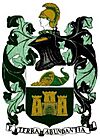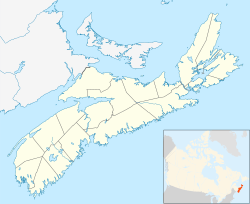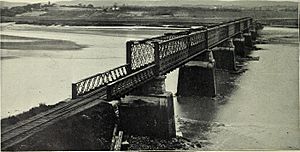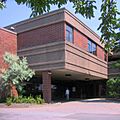Windsor, Nova Scotia facts for kids
Quick facts for kids
Windsor
|
|||
|---|---|---|---|
|
Community
|
|||
|
|||
| Nickname(s):
Birthplace of Hockey
|
|||
| Motto(s): | |||
| Country | Canada | ||
| Province | Nova Scotia | ||
| Municipality | West Hants Regional Municipality | ||
| Founded | 1685 | ||
| Incorporated | April 4, 1878 | ||
| Amalgamated | April 1, 2020 | ||
| Area
(2016)
|
|||
| • Community | 9.11 km2 (3.52 sq mi) | ||
| • Urban | 10.50 km2 (4.05 sq mi) | ||
| Highest elevation | 32 m (105 ft) | ||
| Lowest elevation | 0 m (0 ft) | ||
| Population
(2021)
|
|||
| • Community | 3,425 | ||
| • Density | 400.6/km2 (1,038/sq mi) | ||
| • Urban | 5,248 | ||
| • Urban density | 500/km2 (1,000/sq mi) | ||
| Time zone | UTC-4 (AST) | ||
| Postal code |
B0N 2T0
|
||
| Area code(s) | 902 | ||
| Telephone Exchanges | 306 321 472 790 791 792 798 799 | ||
| Median Earnings* | $24,502 | ||
| NTS Map | 21A16 Windsor | ||
| GNBC Code | CBPAK | ||
| Website | windsor.ns.ca | ||
| *Median household income, 2000 ($) (all households) | |||
Windsor is a community in Hants County, Nova Scotia, Canada. It's a key service center for the western part of the county. The community is located right on Highway 101.
Windsor has a long history. The Mi'kmaq Nation lived here for thousands of years before Europeans arrived. Later, French settlers called Acadians lived in the area. The town is famous for being the birthplace of ice hockey. It was also home to Thomas Chandler Haliburton, Canada's first internationally best-selling author.
On April 1, 2020, the Town of Windsor joined with the District of West Hants. They became the West Hants Regional Municipality.
Contents
History of Windsor
The first Europeans to settle in this area were the Acadians. They arrived in the early 1680s from Port Royal, Nova Scotia. French records from 1686 show they had farms using special dyked marshlands. The Mi'kmaq people called this area "Pisiguit," meaning "Junction of Waters." This name referred to where the Avon and St. Croix rivers meet.
Early Conflicts
Raid on Pisiquid (1704)
During a time of war, in 1704, a group from New England attacked Pisiquid. They burned down 40 houses, along with barns, crops, and cattle. This event was a response to earlier attacks on New England settlements.
Fort Edward and the Acadians
Even after the British took control of Nova Scotia in 1710, many Acadians and Mi'kmaq people still lived there. In 1749, the British started building new settlements like Halifax. To protect these new towns, they built forts. One important fort was Fort Edward in what is now Windsor. This fort was built in 1750.
Many Acadians left the area before the Expulsion of the Acadians. During the French and Indian War, Fort Edward was used to hold Acadians. They were told they would be deported from Nova Scotia. Thousands of Acadians were sent away on ships, often separated from their families.
New Settlers Arrive
New England Planters
The Township of Windsor was officially started in 1764 by settlers from New England. The very next year, in 1765, the first Agricultural Fair was held here. This fair is still happening today. It is the oldest and longest-running fair of its kind in North America!
American Revolution and Loyalists
During the American Revolution, Windsor was an important British base. Fort Edward was the main headquarters for British forces in Atlantic Canada. After the war, many United Empire Loyalists settled in Windsor. These were people who stayed loyal to Britain.
The Plaster War
Windsor had rich deposits of gypsum, a mineral used for plaster. This gypsum was often sold to American markets, sometimes illegally. In 1820, officials tried to stop this smuggling. This led to a conflict known as the "Plaster War." Local smugglers won, and the trade continued.
Education and Famous People
King's College and King's-Edgehill School
The University of King's College was founded in Windsor in 1788. It was an Anglican school. A big fire in 1920 destroyed the college. It then moved to Halifax in 1922.
The secondary school, King's Collegiate School, stayed in Windsor. In 1890, a girls' school called 'Edgehill School' opened nearby. In 1976, these two schools joined to form King's-Edgehill School. It is now the oldest independent (private) school in the Commonwealth outside of the United Kingdom.
Thomas Chandler Haliburton
Thomas Chandler Haliburton made Windsor famous in the 1800s. He wrote popular stories about a character named Sam Slick, a clockmaker.
Growth and Transportation
Ships, Rail, and Roads
In 1878, Windsor officially became a town. Its harbor was very important for shipping and shipbuilding. Many large merchant ships were built here. Windsor was the homeport for one of Canada's largest fleets of sailing ships.
The railway arrived in 1857, connecting Windsor to Halifax. This made Windsor an important link for shipping goods by steamship. The railway expanded over time, eventually connecting to Yarmouth.
Windsor faced a major fire on October 17, 1897. It destroyed about 80% of the downtown area. Around 2,500 people lost their homes. Rebuilding took several years. Another fire in 1924 also caused damage.
The railway helped Windsor grow. Many factories, like textile mills and furniture factories, were built. The Shand House Museum in Windsor preserves the home of one of these industrial families.
In 1970, a causeway was built across the Avon River. This causeway carries Highway 101 and the railway. It cut off Windsor from shipping by sea. The river upstream from the causeway is now called 'Lake Pisiquid'. There are talks about replacing the causeway with bridges to help the river flow better.
Geography and Climate
Windsor is located where the Avon and St. Croix Rivers meet. It is the largest community in the District of the Municipality of West Hants.
Weather in Windsor
Windsor experiences a range of temperatures. The hottest temperature ever recorded was 37.8 degrees Celsius (100 degrees Fahrenheit) on August 19, 1935. The coldest was -32.5 degrees Celsius (-26.5 degrees Fahrenheit) on February 7, 1993.
| Climate data for Windsor (Martock), 1981–2010 normals, extremes 1871–2005 | |||||||||||||
|---|---|---|---|---|---|---|---|---|---|---|---|---|---|
| Month | Jan | Feb | Mar | Apr | May | Jun | Jul | Aug | Sep | Oct | Nov | Dec | Year |
| Record high °C (°F) | 18.5 (65.3) |
19.5 (67.1) |
27.0 (80.6) |
28.5 (83.3) |
34.0 (93.2) |
35.6 (96.1) |
35.0 (95.0) |
37.8 (100.0) |
34.0 (93.2) |
30.0 (86.0) |
22.0 (71.6) |
17.5 (63.5) |
37.8 (100.0) |
| Mean daily maximum °C (°F) | −1.0 (30.2) |
0.2 (32.4) |
4.0 (39.2) |
10.1 (50.2) |
17.1 (62.8) |
22.1 (71.8) |
25.5 (77.9) |
25.1 (77.2) |
20.6 (69.1) |
14.2 (57.6) |
8.0 (46.4) |
2.4 (36.3) |
12.4 (54.3) |
| Daily mean °C (°F) | −5.5 (22.1) |
−4.4 (24.1) |
−0.6 (30.9) |
5.3 (41.5) |
11.3 (52.3) |
16.2 (61.2) |
19.9 (67.8) |
19.5 (67.1) |
15.2 (59.4) |
9.4 (48.9) |
4.2 (39.6) |
−1.6 (29.1) |
7.4 (45.3) |
| Mean daily minimum °C (°F) | −9.9 (14.2) |
−9.1 (15.6) |
−5.2 (22.6) |
0.4 (32.7) |
5.5 (41.9) |
10.3 (50.5) |
14.2 (57.6) |
13.9 (57.0) |
9.8 (49.6) |
4.6 (40.3) |
0.3 (32.5) |
−5.6 (21.9) |
2.4 (36.3) |
| Record low °C (°F) | −29.4 (−20.9) |
−32.5 (−26.5) |
−23.9 (−11.0) |
−13.9 (7.0) |
−5.0 (23.0) |
−2.2 (28.0) |
3.3 (37.9) |
0.0 (32.0) |
−2.5 (27.5) |
−7.8 (18.0) |
−16.7 (1.9) |
−25.0 (−13.0) |
−32.5 (−26.5) |
| Average precipitation mm (inches) | 147.1 (5.79) |
107.2 (4.22) |
126.1 (4.96) |
103.3 (4.07) |
95.3 (3.75) |
82.8 (3.26) |
83.9 (3.30) |
76.3 (3.00) |
105.6 (4.16) |
108.8 (4.28) |
143.6 (5.65) |
129.7 (5.11) |
1,309.6 (51.56) |
| Average rainfall mm (inches) | 71.9 (2.83) |
54.6 (2.15) |
83.2 (3.28) |
88.6 (3.49) |
93.7 (3.69) |
82.8 (3.26) |
83.9 (3.30) |
76.3 (3.00) |
105.9 (4.17) |
108.8 (4.28) |
127.0 (5.00) |
84.0 (3.31) |
1,060.2 (41.74) |
| Average snowfall cm (inches) | 75.2 (29.6) |
52.6 (20.7) |
42.9 (16.9) |
14.7 (5.8) |
1.6 (0.6) |
0.0 (0.0) |
0.0 (0.0) |
0.0 (0.0) |
0.0 (0.0) |
0.0 (0.0) |
16.6 (6.5) |
45.7 (18.0) |
249.4 (98.2) |
| Source: Environment Canada | |||||||||||||
Population Changes
| Historical population | ||
|---|---|---|
| Year | Pop. | ±% |
| 1881 | 2,559 | — |
| 1891 | 2,838 | +10.9% |
| 1901 | 3,398 | +19.7% |
| 1911 | 3,452 | +1.6% |
| 1921 | 2,946 | −14.7% |
| 1931 | 3,032 | +2.9% |
| 1941 | 3,436 | +13.3% |
| 1951 | 3,439 | +0.1% |
| 1956 | 3,651 | +6.2% |
| 1961 | 3,823 | +4.7% |
| 1981 | 3,646 | −4.6% |
| 1986 | 3,665 | +0.5% |
| 1991 | 3,625 | −1.1% |
| 1996 | 3,726 | +2.8% |
| 2001 | 3,778 | +1.4% |
| 2006 | 3,709 | −1.8% |
| 2011 | 3,785 | +2.0% |
| 2016 | 3,648 | −3.6% |
| 2021 | 3,425 | −6.1% |
In 2021, the former Town of Windsor had a population of 3,425 people. These residents lived in 1,556 homes. This was a small decrease from its 2016 population of 3,648.
Arts and Fun
Pumpkin Regatta
Windsor is home to the world's first pumpkin regatta. This unique race started in 1999. People carve out giant pumpkins and race them across Lake Pisiquid. Some even attach motors to their pumpkins!
Mermaid Theatre
The Mermaid Theatre of Nova Scotia is located in Windsor. This theater group travels and performs for audiences locally and around the world. They also have many children's theater programs.
Attractions and Activities
Windsor, Nova Scotia, has many fun things to see and do. It is known as the birthplace of hockey.
Hockey History
Windsor claims to be where hockey began. Stories from the early 1800s mention boys from King's Collegiate School playing "hurley" on frozen Long Pond. This pond is next to Howard Dill's farm. Students from King's-Edgehill School still play hockey on Long Pond today. Some call it the "Cradle of Hockey."
Windsor also had the oldest hockey arena in Canada, the Stannus Street Rink. While it no longer hosts games, the town's current arena is Hants Exhibition Arena. Windsor has been home to local hockey teams like the Windsor Royals.
Parks for Play
- Falls Lake Provincial Park
- Victoria Park
- Windsor Playland Park
- Windsor Waterfront Skatepark
Famous People from Windsor
- Scott Brison
- George Elliott Clarke
- Thomas Chandler Haliburton
- Alden Nowlan (from nearby Stanley, Nova Scotia)
- Percy Paris
- Gerald Regan
- Geoff Regan
Sister City
Windsor's sister city is Cooperstown, New York. This connection is special because Windsor is known as the birthplace of Ice Hockey, and Cooperstown is famous as the birthplace of Baseball.
Images for kids







